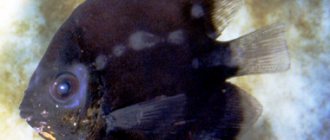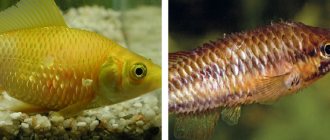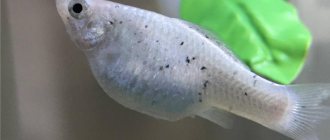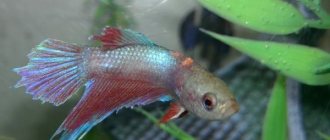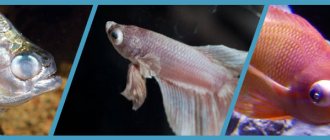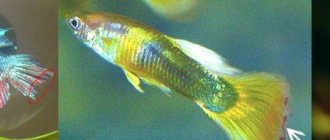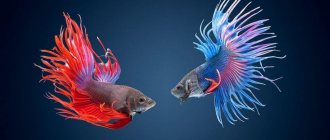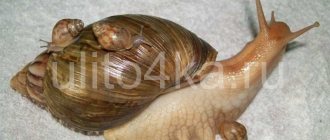Aeromonosis is a bacterial infection that is also known as hemorrhagic septicemia or rubella. It affects many species of aquarium fish, is quickly transmitted from one individual to another and progresses at a high speed. Therefore, it is important to identify the disease in time and begin treatment in order to prevent death and reduce the number of possible complications.
Causes of the disease
The causative agent of the disease is the bacterium Aeromonas punctata. The most susceptible to this disease are fish such as barbs, zebrafish, carp, roach, etc. The causes of aeromonosis are:
- In open water, rubella occurs as a result of a large number of fish. Due to the fact that the pond is not kept properly clean or the bacteria do not have time to process the waste products of its inhabitants, the water becomes dirty and bacteria appear in it.
- In aquariums, most infections occur due to sick fish. At the same time, other individuals do not even have to come into contact with the sick animal - it is enough to be in the same water with it. After all, the source of the bacteria is the secretions of these fish or their remains (for example, scales).
- If there are no sick fish in the aquarium, then infection can occur due to food, soil or soil if they are brought from a natural reservoir. After all, there may be individuals in the lake/pond that are carriers of the bacteria.
Infection zones and susceptible species
In nature, aeromonosis often develops in natural reservoirs, which, due to the environmental situation, are often polluted. The chance increases if there is a waste disposal site nearby from a sewer or some factory. The cooling reservoirs of power plants are also affected , because the enterprise constantly heats the water, cultivating more and more new bacteria.
The disease is also possible in artificial reservoirs if it is brought there by a sick animal or person, which is rare. But if the infection does become widespread, the losses become colossal. Fish unprepared for infections die very quickly and it is not always possible to somehow cope with the epidemic. The only salvation is to monitor seasonal outbreaks of aeromonosis (associated with warm seasons) and, if possible, take preventive measures.
Salmonids most susceptible to furunculosis:
- Brook trout;
- Rainbow trout;
- Palia.
Important! Transporting apparently healthy fish into a clean body of water is strictly prohibited - the animal may already be a carrier of the infection, although the symptoms are not visible.
In practice, all salmon within natural reservoirs are susceptible to infection. Under natural conditions, this rarely causes an irreparable blow to the population, since it is mainly “old” fish (over two years old) that get sick. Fry, as well as replacement young animals, individuals in the process of spawning are protected from aeromonosis.
Symptoms
Correct recognition of symptoms and timely treatment are the key to a favorable outcome of the disease. The following symptoms are typical for fish infected with rubella:
- The appearance of red spots and foci of inflammation on the fish. They often appear on the sides or fins. Redness in the abdominal area and further development of aeromonosis to abdominal dropsy are also possible;
- Some fish experience ruffling of scales (they rise) and their loss;
- Bug-eyed;
- Lethargy;
- Apathy;
- Loss of appetite;
- Constant presence at the surface of the water.
The incubation period of the disease can last from three to thirty days. This number depends on the temperature of the water in which the fish is located. If it lives at temperatures above 25°C, then the disease progresses rapidly and the bacterium multiplies quickly. If the temperature is lower, the disease can become chronic and last up to two months without showing obvious symptoms. In this case, the behavior of the fish will be the same as that of a healthy individual.
Danger of the disease to humans
Under no circumstances should you eat fish that have suffered from aeromonosis; this can lead to gastrointestinal problems in the long term and serious food poisoning. When catching such fish, they must be immediately buried in the ground away from the reservoir so that the disease does not spread further.
On the counter, the carcass of a sick animal is easy to distinguish. No amount of freezing or heat treatment will remove the external symptoms of furunculosis. These are traces of torn ulcers, bleeding wounds, traces of long-faded scales, a pale and sickly appearance, bulging eyes (if the fish is sold with the head). It is illegal to sell such products, since a sick animal poses a serious danger to human health.
Treatment
Aeromonosis is an extremely dangerous disease that is very difficult to treat. Therefore, it is often possible to save only apparently healthy fish that have begun to experience subtle changes in behavior. If an animal exhibits all of the above symptoms (especially the appearance of red spots and ruffled scales), then it is better to get rid of such fish, since treatment will be ineffective. After this, you should thoroughly wash the aquarium, disinfect the plants and soil, and carry out therapy for the neighbors of the sick individual.
It is recommended to carry out treatment in a common aquarium. Such measures will help cure a sick animal and carry out prevention for healthy fish. Therapy is carried out with medication. There are several treatment options using different medications:
- Bicilin antibiotic solution – 5. Proportion 500 thousand units per 100 liters of water. The course of treatment is one week.
- Baths with basic violet K. The course of treatment is a week or more.
- One capsule of doxycycline per 35 liters of water in combination with chloramphenicol (500 mg per 25 liters of water) and nystatin (25 thousand units per 50 liters of water).
- Treatment of sick fish in containers with chloramphenicol or synthomycin. Animals are left in such baths for 10–12 hours.
- Daily cleaning of the aquarium and changing the water.
- Maintaining temperature between 26°C and 30°C.
- Good air aeration.
For effective treatment, you need to choose one of the options for medicinal use and fulfill all the requirements for the cleanliness of the aquarium. Only in this case can the life of the fish and the health of its neighbors be saved.
Rubella of carp fish: symptoms, treatment.
Rubella of carp fish - nature of the disease and treatment methods
“ Rubella of carp fish is not the name of any one specific disease, but a complex of symptoms characteristic of several diseases with different pathogens (viral nature - Spring viraemia of carp , SVC and bacterial - aeromonosis , pseudomonosis and, possibly vibriosis ).
Thus, “rubella” of carp, goldfish, and aquarium fish can be caused by both viruses and several types of bacteria. Moreover, the possibility that both viruses and bacteria at the same time cannot be ruled out. Many aquarium fish, primarily cyprinids and labyrinths, also suffer from similar symptoms. It should be noted that the symptoms of rubella are very similar to ammonia poisoning of fish and in order to make a correct diagnosis you must be able to test water for ammonia. If there are symptoms of rubella and there is no ammonia in the aquarium water, one can suspect the disease rather than poisoning.
Carp sick with rubella, acute course of the disease.
Carp, sick with rubella, chronic course of the disease.
Let us list the symptoms of cyprinid rubella , which can appear in various combinations in pond and aquarium fish : - hemorrhages throughout the body, but mainly in the head, abdomen and base of the fins; - bulging eyes; - ruffled scales; - protrusion of the anus; - release of fluid when pressing on the abdomen; - dropsy (ascites); - ulcers on the body; These symptoms are clearly visible in the photos and videos below. It should be noted that they do not always appear all together. Fish infected with rubella usually do not show all of these symptoms at the same time.
| Video 1. Rubella affects any carp (and not only!) aquarium fish of different species, including zebrafish. The video shows all the symptoms of the disease. In this case, the disease took the form of bacterial septicemia. Of the symptoms listed above, bulging eyes, developing dropsy, and hemorrhages on the body (well visible on the head) are clearly visible. |
| Photo 1. Symptoms of cyprinid rubella in goldfish (Riukin variety). Hemorrhages (hemorrhages) are visible on the snout, around the eyes, on the gill covers and just behind the gill covers, at the base of the fins and on the fins. The disease is caused by cooling the fish for transportation 1) and crowding during transportation (The fish have traveled a long way: Singapore - St. Petersburg, travel time is more than 30 hours). A few days later, the indicated symptoms of the disease appeared. |
| Photo 2. A symptom of rubella (aeromonosis, pseudomonosis) is extensive hemorrhage in the infraorbital blisters and on the head, especially around the mouth. The photo shows a special variety of goldfish - “water eyes”. Infraorbital blisters in themselves are not a symptom of rubella; they are a characteristic sign of this variety; normally they are almost transparent. In a sick fish, the liquid in the bubbles becomes cloudy, and dilated blood vessels become clearly visible in the walls of the bubbles. Subsequently, the vessels burst and extensive hemorrhages occur (arrow). In ornamental fish farming, fish can have a bizarre appearance, and an ichthyopathologist working in this area needs to know the characteristic features of the variety in order not to confuse them with symptoms of diseases. |
| Photos 3 and 4. Ammonia poisoning, in this case chronic, must be distinguished from the symptoms of rubella. In case of poisoning, hemorrhages are also observed at the base of the pectoral fins and under the gill covers (arrows). The ammonia test shows a high level of ammonia in the aquarium water, so ammonia poisoning should be considered the cause of hemorrhages. |
An aquarist can cope with this fish disease by using immunomodulators (roncoleukin at the rate of 50,000-100,000 units per 10 liters, human leukocyte interferon - 1 ampoule per 30 - 35 liters) in combination with sera Baktopur direct, or with chloramphenicol (2.5 g per 100 l - adding at least a third of the water volume one day after replacing. When treating in a general aquarium with chloramphenicol, biofiltration will be noticeably suppressed after the second application of the drug, so anti-ammonia or ammolok must be used at the same time.
| Photo 5. The photo shows an ulcerative form of cyprinid rubella in a goldfish. Achieving healing of an ulcer is not so easy. Treatment should be combined and combine long baths in antibiotics and local treatment of the ulcer with betadine (povidone-iodine). To do this, the fish is caught, the area of the body around the ulcer is dried, and the ulcer is “cauterized.” Treatment of the ulcer should be done once a day, every other day or every day (if the fish tolerates the operation easily), until the ulcer heals. Treatment will be more effective if the fish lives in water with the addition of pimafix melafix (medicines based on phytoextracts from API, which can be successfully replaced by NILPA Alterfix). |
| Photo 6. Ulcerative form of aeromonosis in pearl goldfish. The arrow points to a healing ulcer, which as a result of treatment almost no longer bleeds. |
| Photo 7. Ulcerative chronic form of rubella in koi carp; treatment of the fish will be very difficult and will take several weeks. |
Treatment for rubella can take from 10 days to a month or more. The ulcerative form of the disease is especially difficult to treat, which is best treated using a combination of doxycycline (1 capsule 100 mg per 30-35 l + chloramphenicol (500 mg per 20 l) + nystatin (200,000 units per 30-35 l). During treatment, it is necessary to provide high (at least 5 mg per l) oxygen content in the water (provide very good aeration). In chronic and subacute forms of rubella, fish take food. Soaking feed granules in “vetom starter” with the addition of ascorutin significantly speeds up treatment.
| Video 2. It is not difficult to prepare vetom culture liquid (vetom starter). This video shows how. Did you like the material? Watch the film to the end and put it on YouTube. This will contribute to the development of the Aquarium channel and website. In addition, you can help Aquarium yourself. |
Treatment of cyprinid rubella in aquarium fish is not such an easy matter. The treatment recipes given here have been tested over many years of practice and are quite effective. However, sometimes you may need “club help” and we are always ready to help: contact the forum for illness and treatment of aquarium fish . An example of successful treatment of carp rubella in pseudogastromyzons with streptomycin.
1) Before transportation, goldfish are specially cooled. This allows you to put a significantly larger number of fish in the transport package. Back to text.
Author:
Vladimir Kovalev updated 10/28/2016
In St. Petersburg, you can get detailed advice on diseases of aquarium fish, bring fish for diagnosis and learn about methods of treating diseases at the AquaInterio aquarium hypermarket. In particular, there you can make an appointment with the author of this article.
At AquaInterio you can purchase treatments for aquarium fish from the world's leading manufacturers of aquarium products: JBL, SERA. API and others.
Prevention
There are no special rules for the prevention of aeromonosis. All recommendations that should be followed are based on compliance with sanitary and hygienic standards in the aquarium.
- Frequent water changes and careful treatment of interior items.
- Control over the origin of soil, soil and food.
- Carefully observe the behavior of fish.
- Good aeration.
It is important to understand that most diseases in fish occur as a result of poor living conditions and insufficient control by the owner. Therefore, in order to keep the aquarium inhabitants healthy and the aquarium itself beautiful, you need to carefully care for it and not miss the first suspicious signals.
Preventive measures, ways to cure the population
In a natural environment, fish can heal on their own, but in an artificial reservoir the entire population, not accustomed to fighting infections, can die . To prevent this, monitor seasonal outbreaks of the disease; they occur during the warm season when bacteria multiply.
Preventative tips:
- If a fish in a nearby body of water (relatively close) or a nearby natural one is sick, limit all contact with that aquatic environment.
- Monitor the behavior of animals during the warm season, and immediately isolate suspicious animals.
- Increase the diet of fish during the warm season - a strong body fights infection better.
Reference! The only thing you can do in a large, albeit artificial, reservoir is control and catching. Spare no effort on full monitoring and you will be able to save most of the fish even in the most critical cases.
Control measures
Treatment of carp aeromonosis is carried out under quarantine conditions - infected ponds are isolated from the rest. The main and most effective way to combat aeromonosis is rapid diagnosis of the disease and therapeutic and prophylactic treatment of fish with the Antibak series drug at the onset of the disease.
In addition, the following measures are taken to interrupt the infection cycle:
Flying.
In the fall, all fish are caught and sorted: healthy individuals can be sold (provided there is no contact of the caught fish with guaranteed healthy reservoirs), sick individuals are destroyed. All water from the reservoir is drained, after which, throughout the year, sludge is removed and complete disinfection is carried out (both the reservoir and all tools, containers, clothing, etc. that came into contact with contaminated water, fish and feed). The pond is dried and left in this form for its natural treatment by negative temperatures and ultraviolet radiation.
To disinfect a reservoir, quicklime or bleach is used (25 c/ha or 3–5 c/ha, respectively). To disinfect containers, clothing, etc., boiling, 4% formaldehyde solution or other means are used.
Complex method
. All water bodies within the fishery are alternately subjected to summer flights. Monitoring of drained ponds is carried out by workers assigned to them, using separate equipment.
Quarantine from a fishery can be lifted no earlier than 12 months after the last case of fish infection, as well as after the absence of pathogens in samples taken from water bodies.
